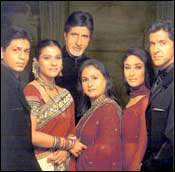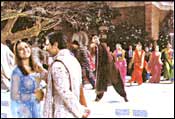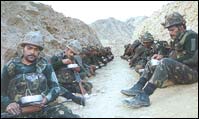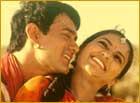 A great problem has run amok in Indian cinema over the past decade. There is a trend of so-called blockbusters which most filmmakers conform to over about two genres.
A great problem has run amok in Indian cinema over the past decade. There is a trend of so-called blockbusters which most filmmakers conform to over about two genres.
These genres have several elements in common, all which fly in the face of logic and reality, and display a blatant disregard towards the intellect of the audience.
For argument, and for lack of better terms, I will refer to the genres as Family Love Stories and War Movies.
Family Love Stories
A few examples of films which adhere to the conventions of this genre include such works as Kabhi Khushi Kabhie Gham, Main Prem Ki Diwani Hoon, Taal, Pardes, Mujhse Dosti Karoge, and Kal Ho Naa Ho.
They are quite often released under the Rajshri, Yash Raj Films, or Mukta Arts Ltd banners.
What do these films have in common?
First, the very obvious. A good number of these films make a fairly ridiculous assumption about the demographics of the Indian public that they portray. It seems the main characters are almost always two things: very rich and very Punjabi.
These people are the king of kings, live in grand palaces the size of which would put the Maharajas to shame. They drive more Porsches and BMWs than these companies probably produce in a year in India. They only wear top-of-the-line designer clothes and accessories like Polo, Gucci or Prada.
All this supposedly happens in a country where the middle class family is lucky to own their home; where spending Rs 400 to take your family out to a movie is considered a luxury; where so many people live an agrarian lifestyle and survive on basic sustenance.
As for the Punjabi element, the characters portrayed in these movies often have one of four possible last names: Malhotra, Khanna, Kapoor or Chopra. With that Punjabi identity comes the need to Bhangra and mouth off songs that undoubtedly begin or end with 'Soniye' or 'Mahive.'
One thing there is no shortage of in India is diversity in culture, customs and language. That is what makes India beautiful. So to release movies which repeatedly focus on just one subculture and call that 'mainstream Hindi cinema' would be an insult.
To contrast, the majority of the American public is by and far Anglo-Saxon Caucasian. That has not stopped shows with an all-white cast (i e Friends) from receiving a lot of flak in the American media as being too ethnocentric.
Why has this issue been so conveniently ignored by the Indian media?
Another convention for movies in the family love stories genre is the absolute lack of a meaningful and coherent storyline. They are simply star and song-driven vehicles that hype themselves based on their oft-repeated star cast (Shah Rukh Khan, Hrithik Roshan, Kareena Kapoor or Amitabh Bachchan), or on their music (Jatin-Lalit, Anu Malik, and sometimes A R Rahman). This is evident from the way the Indian media focuses on the 'music' and 'promos' of the movies before their release.
As for the paper-thin storyline and lack of logical progression in the script, that is just not important. We are supposed to ignore that all the students at a British university can mouth Hindi lyrics and dance in step with Kareena Kapoor and Hrithik Roshan (Kabhi Khushi Kabhie Gham). Or that Preity Zinta can jog all over New York City in Kal Ho Naa Ho as if it is Disneyland instead of a sprawling metropolis.
 The miniscule story usually involves love triangles, quadrangles or whatever. There is nothing wrong with a well-told love story. The problem is none of these stories are believable. The 'love' between the characters is often reduced to something superficial and is purely looks-based (boy sees girl on college Friendship Day or Valentine's Day or Groundhogs Day and immediately falls in love. And before you know it, the next song is Soni kitni gori lagti ve).
The miniscule story usually involves love triangles, quadrangles or whatever. There is nothing wrong with a well-told love story. The problem is none of these stories are believable. The 'love' between the characters is often reduced to something superficial and is purely looks-based (boy sees girl on college Friendship Day or Valentine's Day or Groundhogs Day and immediately falls in love. And before you know it, the next song is Soni kitni gori lagti ve).
The directors then throw in a guest star or an item number to drive the audience wild and divert their attention from the mounting shortcomings of the film. These five to 15 minutes of screen time often bring the guest star a lot of praise and adulation, with the Indian media immediately declaring that the career of the guest star has been revived or their performances 'greatly appreciated.'
It is of no concern to anyone if the appreciation stems from how vulgar the item numbers or how corny the few lines the star had to speak actually were. Note: Salman Khan in Kuch Kuch Hota Hai, Rani Mukerji in Kabhi Khushi Kabhie Gham, Abhishek Bachchan in Main Prem Ki Diwani Hoon, and Shamita Shetty in Mere Yaar Ki Shaadi Hai, to name a few.
To add the emotional element, the directors of these movies often overdose on glycerine. I suppose seeing every character and their pet cry for hours in KHNH may have had some emotional impact on a part of the audience.
A far more emotional movie was the action-packed third instalment of the Lord Of The Rings trilogy. The characters and story were so well etched that I could identify with and feel for every character. Their victory and their losses were more true and heartfelt than Shah Rukh Khan's half-baked love story in KHNH.
All in all, this genre considers telling a good story secondary to showing off huge mansions, fancy clothes, Bhangra numbers and foreign locales.
So why should the producers care?
The public loves it. The media adores them.
War Movies
A few examples of this particular genre include Qayamat, Zameen, Border, Sarfarosh and please insert any recent Sunny Deol movie title here.
While these films often portray themselves as epic struggles that Indians go through in the name of survival, they are at their core nothing more than Pakistan-bashing mediums. What begins as a matter of national security ends in hurling such charming epitaphs as dushman desh and harami mulk at our neighbor.
Just to seem politically correct, the directors of such movies sometimes ensure that one of the good Indian characters is Muslim. The senseless logic being to distinguish between the 'good' Muslims of India and the 'bad' Muslims of Pakistan. Note the characterisations of Mukesh Rishi in Sarfarosh and Suniel Shetty in Qayamat.
Another attribute of these films is that they sometimes generate free publicity via controversies with the censor board and/or threats of bans from political and religious organisations.
The biggest issue with war movies is that, ultimately, they may be a bigger threat to national security then any dushman desh. By blatantly attempting to inflame anti-Pakistan passions within an oft-uneducated public, they have the potential to ignite communal violence and increase political tensions.
Now it seems both countries are attempting to mend a 50-year-old rift and build new political, business and social ties. We seriously do not need immature movie directors out to make a quick buck feeding fresh fuel to the flame.
But why should they care?
The public loves it. The media adores them.
The Core Problem
Why do such movies get made over and over again until there is virtually nothing to distinguish them apart?
We the audience are primarily to blame. We would rather flock to a big budget star-driven production of a major banner than an independent film that dares to take a different look at the world. We would rather see half-hearted Hindi remakes of regional hits from South India and Bengali cinema, than view the original product with subtitles. We would rather embrace movies that were 'inspired by' other films (read scene to scene blatant copy) than see something refreshingly new.
 We do not seem to particularly care if the film has more holes than a Mumbai highway. We do not care if we have witnessed our millionth love triangle or billionth item number. As long as we can go to sleep mentally for three hours, we are more than willing to fork over the cash.
We do not seem to particularly care if the film has more holes than a Mumbai highway. We do not care if we have witnessed our millionth love triangle or billionth item number. As long as we can go to sleep mentally for three hours, we are more than willing to fork over the cash.
Just as equally to blame is the Indian media which reverently covers such films and declares them to be the next greatest thing to hit the big screen.
Media-driven major award shows like Filmfare celebrate these films as the finest that India has to offer. Finest in terms of box-office or content? If it is content, only a fool can say with a straight face that a moving and well-written script like that of Pinjar or Teen Deewarein was not better than Kal Ho Naa Ho or Chalte Chalte.
While Filmfare makes no qualms about being a popular awards show, the problem is how the media portrays this as India's answer to the Oscars. With all due respect, this is an insult to the Oscars and what they stand for.
As a list of some of the past Oscar winners proves, it isn't necessarily big-budget and big-hype movies that get nominated or even win. If that were the case, Spiderman would have swept house at the show last year. The Oscars are based, mostly, on talent and achievement, whereas Filmfare seems to simply base itself on which movie made the most money.
For example, it was surprising to see how the Indian media made a big issue out of Devdas not being nominated for the Oscars last year. On what basis was Devdas expected to be Oscar material? Its garish sets or costumes? Aishwarya Rai's constant flow of tears and wild screaming? Or for the original storyline which dealt with (drumrolls please) a love triangle?
A part of the media felt that since Lagaan was nominated once, it had virtually become India's annual birthright to get to the Oscars. What they ignored was that Lagaan had something many big budget Hindi movies don't: a heart. It had good direction, stirring performances and a touching storyline that showcased how political battles can be won peacefully (on a cricket field) without resorting to violence.
 I don't doubt that most of the top 5 movies of the year will star either Shah Rukh Khan or Hrithik Roshan in banner films or have an anti-Pakistan stance. As consumers, we truly vote with our money. And if we continue to spend on such films, they will continue to be made far into the future.
I don't doubt that most of the top 5 movies of the year will star either Shah Rukh Khan or Hrithik Roshan in banner films or have an anti-Pakistan stance. As consumers, we truly vote with our money. And if we continue to spend on such films, they will continue to be made far into the future.
It is to our benefit to experiment in what we watch. The media also has a role to give greater coverage to smaller independent filmakers wanting to tell a real story, and to cover more award shows like the National Awards with the same gusto they reserve for Filmfare.
It is time we demand more from some of our big banners and refuse to eat the garbage they stuff down our throats.
Vaibhav Kothari is 23 years old and lives in New York City







